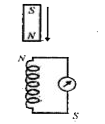State Lenz's law. Give one example to illustrate this law. "The Lenz's law is a consequence of the principle of conservation of energy." Justify this statement
Text Solution
Lenz.s law determines the direction of induced current. According to this law, the induced.curreat produced in a circuit always flows in a direction that it opposes the change or cause which produces it. Lenz.s rule and law of conservation of energy Consider a solenoid connected to a galvanometer. Let a bar magnet with its north be moved towards the coil. Due to the movement of magnet, the magnetic flux linked with the coil changes and the induced current is produced. According to Lenz.s law, the . . direction of induced current opposes the cause, (motion of magnet). In order to oppose the cause, upper end becomes north pole. So to move the magnet towards coil, we have to work against force of repulsion. This mechanical work converts into electric energy. So Lenz.s law is in accordance with the law of conservation of energy.

|
Updated on:21/07/2023
Similar Questions
(a) State Lanz's law. Give one example to illustrate this law. "The Lenz's law is a consequence of the principle of conservation of energy." Justify this statement.
(b) Deduce a expression for the mutual inductance of two long coaxial solenoids but having different radii and different number of turns.View Solution(a) State Lens law. Give one example to illustrate this law. '' The Lenz's law is a consequence of the principle of conversation of energy .' Justify this statement.
(b) Deduce an expression for the mutual inductance of two long coaxial solenoids but having different radil and different radil and different number of turns.View Solution
Knowledge Check
- Question 1 - Select One or More
Lenz's law is a consequence of the law of conservation of
AchargeBmomentumCmassDenergy - Question 2 - Select One
Lenz's law is consequence of the law of conservation of
Acharge onlyBmomentum onlyCenergy onlyDenergy and momentum. - Question 3 - Select One
Lenz's law is consequence of the law of conservation of
AChargeBmomentumCmassDenergy

